How to Build a Pokemon Deck
Building a Pokemon TCG deck on your own is no easy task. With so many cards available to use, it’s your job to pick out 60 cards that would work together to create a winning strategy. But, how do you choose? In this article I will discuss some basic guidelines that can help you unleash the full potential of your deck.
Focus
A deck should ALWAYS have a focus! How are you going to beat the opponent? Are you going to wall them out until they draw out, are you going to deck them out, shut them off from using items, or are you going to win the prize battle? This needs to be decided up front and then go towards that one goal.
Consistency
If you really want a Tier 1 deck that can hold it’s own against any and all match ups and make it to a higher level tournament someday, then you need an absolutely consistent deck. Look at a list of all the major Pokemon TCG Master and Senior division championships that have been won since the start of Pokemon TCG and look at the decks that were used.
To improve the consistency of your deck, play it a couple times. While you do this you can also create a log of your plays. This would be keeping track of how many loses you had because you couldn’t find a certain card and how many times you drew into a dead hand because you didn’t have any draw support. If you had a great startup but found yourself low on energies mid-game then you should add some more energies, ways to search them from the deck, or ways to get them from the discard pile (depending on your situation). If you find yourself getting stuck with bad hands and no way to get out of them try adding a Pokemon, trainer, or supporter that can help you recycle your hand. Keeping track of why you are losing is the best way to fix it. If there is any one part of this article that you take with you and you forget everything else, remember that an amazing deck has to be absolutely consistent over everything else.
Cover Your Weakness
Make sure you understand what your deck is weak against (Pokemon type, play styles). And then adjust your deck a accordingly based on how big of a problem they are/how often you think you will run into them. That way when someone thinks they have the upper advantage against you just by looking at your start, you can throw them off their strategy mid-game. Understand what your weaknesses are and plan ahead to counter them as best as you can.
Energy Acceleration
Being able to attach more than one energy per turn is probably the second strongest core strategy other than draw power. Being able to go through your energies faster then one per turn not only allows an already quick deck to become turn 2 killer, but it also helps you have a backup attacker ready. If your deck doesn’t have any ways of adding energy acceleration to it then don’t worry, but if there is a way then it will probably be worth the card space to include it.
Pokemon
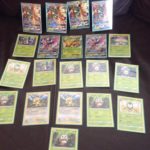
All the Pokemon in my Grass Deck
Start by finding a Pokemon that you like. If it is a Stage 1 or Stage 2 Pokemon, try to put two or three in the deck, and four of the Basic Pokemon. After the favourite Pokemon has been picked, try to find other Pokemon of the same type (Fire, Water, Grass, Electric, etc.), to compliment the main Pokemon. If you want, you can have multiple different types of Pokemon in the deck, but for a new player, it’s best to limit it to one or two types. Just make sure you don’t have more than four of any one card. You may think that you should have 20+ Pokemon cards in a deck to make sure that you have Pokemon available for every scenario, but this is actually going to hurt you in the long run. Most decks run around 12ish Pokemon cards. The reason for this is because you never want to be stuck with a dead hand (a hand where you have a bunch of cards that you can’t play). Once you have your Pokemon chosen, it’s time to move onto Energy.
Energy
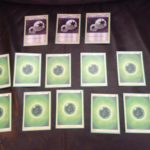
Energy is needed to power the Pokemon’s abilities. Try to match the symbols on the Pokemon in the deck. The average amount being about 8-12 energies per deck. If the deck has Pokemon of two different types, make sure to include Energy of both types. You can have as many copies of Basic Energy cards as you like. Special Energy are also an option. They can be more versatile, but a deck can only have four of any kind of Special Energy. It’s also important to note that very few competitive level decks ever have more than two types of energies, with most of them only having one type. Having more than two types of energies in your deck threatens your ability to find the energies you need for the right Pokemon. Another thing to consider is most decks run 6-15 Pokemon, meaning that trainers are definitely the important bulk of of the deck.
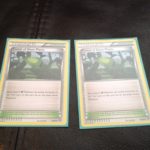
Trainer Cards
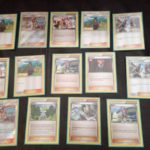
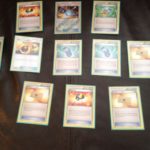
When picking Trainer cards, try for a good mix of Items and Supporters. Here’s why: during a player’s turn, only one Supporter can be player, but multiple Items can be played. Stadiums behave differently; they sit between two players and affect both players whereas most cards only affect one player. Again, there can only be a maximum of four copies of any Trainer card in your deck. Trainers are a unique concept for a card. They have an incredible amount of uses, but don’t really do anything special by themselves. There are disruption trainers that aim at throwing off your opponent (detaching energies, making them do less damage, higher retreat cost, forcing a switch, etc.). There are draw trainers that help you build a better hand, or even completely scrap it for a newer/fresher hand. Hand play-ability is everything. Energy trainers help you find energies from the deck, attach extra energies in a turn, or get them back from the discard pile. Phase trainers focus on allowing you to switch your active Pokemon or force the opponent to switch. Tools are trainers that can be attached to your Pokemon to give them a needed boost or extra effect. Pokemon trainers help you find Pokemon from the deck or get them back from the discard. Supporters are a special type of trainer card that can do any of the above things I mentioned, but you can only use one per turn. The reason this becomes important is that most supporters have better abilities than normal trainers, but some of them have the same effect. Ultimately you should remember that the Supporters’ main focus is for greater draw.
Karen Fullowka
Latest posts by Karen Fullowka (see all)
- How to Build a Pokemon Deck - March 28, 2017
- Cute But Deadly - March 25, 2017
- Who I Am and How To Play Pokemon - March 13, 2017

Leave a Reply
Want to join the discussion?Feel free to contribute!